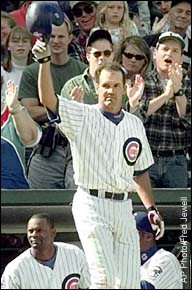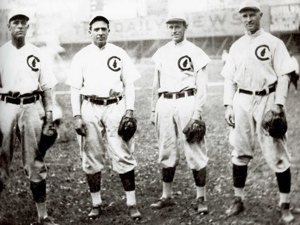|
|
 |
|
Chicago Cubs History
The Early Days
The franchise was established under the name of
the White Stockings. This was after the creation of the National League, and the expansion of many teams. The ball club was
influenced by the Cincinnati Red Stockings, which proved to be a successful baseball franchise. The club were constant contenders,
but were put to a stop during their first years when the Chicago Fire occurred and destroyed most of the teams equipment.
After years of cruising through games and being successful, another baseball leagues had emerged. It was the American Association,
which rivaled with the National League. The more prolific teams of the two leagues were the Chicago White Stockings and
the St. Louis Browns, which is known as the St. Louis Cardinals today. During the timeframe of the White Stockings, Cap Anson
was a key player and the manager for 20 years. Under his management, the team was known as the Colts.
|
 |
|
Tinker Evers Chance
At the turn of the century, the team
changed its name to the Chicago Cubs, which emerged as one of the best teams during the 1903-1910 seasons.
The infield trio of Joe Tinker, John Evers, and Frank Chance dominated baseball as they won 4 national league championships
in 5 years. The trio, along with an outstanding pitching staff, won 2 World Series championships. They were remembered with
a poem called “Baseball’s Sad Lexicon”, by Franklin Pierce Adams. In 1913, the trio broke apart and went
their separate ways.
Wrigley in Charge
After the glory years of the early 1900s,
the team preformed poorly, and suffered a lengthy drought of the playoffs. However, the team’s fortune would change
when ownership was sold to William Wrigley, the man in charge of the chewing gum company tycoon. Wrigley would then hire Will
Veeck, a genius at baseball, into the Cubs’ services. With Wrigley serving as the financial backbone of the organization,
and Veeck as the brains, they constructed a team that would be strong contenders for the next decade. Oddly, the team would
win a pennant for the national league every 3 years, though unsuccessful at claiming the title of world champions, (1929,
1932, 1935, and 1938). After the success, the masterminds of the Cubs would soon be gone. Wrigley and Veeck died during the
late 1930s, and Wrigley’s son, P.K. Wrigley became the new onwer to the Cubs. However, P.K. would not be able to
rekindle what his father had brought to the team.

|
| Ernie Banks (Mr. Cub) |

|
| Ryne Sandberg |
|
 |
|

|
| Cubs infield during the championship years |

|
| Cubs logo during 1969 season |
The Curse of the Billy Goat
During the 1945 World Series, the Cubs
were facing the Detroit Tigers. During game 4 at Wrigley, Billy Sianis was ejected from the stadium along with his goat for
disrupting fans. Sianis was outraged, and felt that the Cubs organization had insulted him and his goat. At that time, Billy
cast a curse upon the Cubs, saying that they will never again win a pennant or play the World Series ever. The Cubs would
soon lose Game 4, and ended up losing the World Series that year. Sianis’ word still holds true today. Most recently,
the Cubs were on track to claim the NL wild card but had a major collapse, winning 2 out of 11 games during the final week
of the regular season of 2004.
The Drought
Compared to the major sports in America,
(baseball, basketball, football, and hockey), the Cubs has the longest championship drought at 99 years. That means that the
Cubs haven’t won the World Series Championship for 98 seasons. The team was inconsistent with only six back to
back winning seasons after the curse was cast upon the Cubs. However, throughout the drought, postseason hope occasionally
glimmered upon the Cubs fans, and superstars would emerge like Ernie Banks, Sammy Sosa, Greg Maddux, Ryne Sandberg, and countless
others. Sadly, these superstars would never reach to the World Series, at least with the Cubs.
|
 |
|
|
 |
|
|
|
|
|
Turn of the Century
At the start of the year
2000, the team never returned to their 1998 form, but rather took another direction like building their team around youngsters
like Kerry Wood and also veterans like Sammy Sosa. The team saw a departure to the aging Mark Grace, and welcomed newcomers
like Moises Alou and Matt Clement. Before the 2003 season, the media and fans had low expectations for the
Cubs, but the coming of manager Dusty Baker changed the attitude. Also, the general manager, Jim Hendry, made spectacular
trades like acquiring Mark Grudzielanek, and Eric Karros for the bust, Todd Hundley. When the push for the playoffs were apparent,
Hendry traded away young prospects for backup first basemen Randall Simon, the speedy Kenny Lofton, and the young third baseman,
Aramis Ramirez. The team succeeded to edge the Astros for the team’s first National League Pennant in many years. Sadly,
the team fell apart in the playoffs, due to countless miscues and inconveniences. But the team didn’t give up, as the
2004 team looked stronger than ever. Greg Maddux signed to start his second tour with the Cubs, but problems arose. Both Kerry
Wood and Mark Prior was plagued with injuries,
abd never fully recovered to this day. After a 2004 season where the Cubs missed out on a chance for the wildcard
spot, Sammy Sosa was traded away, but suffered a sub .500 for the next two years.
|
|
|
 |

